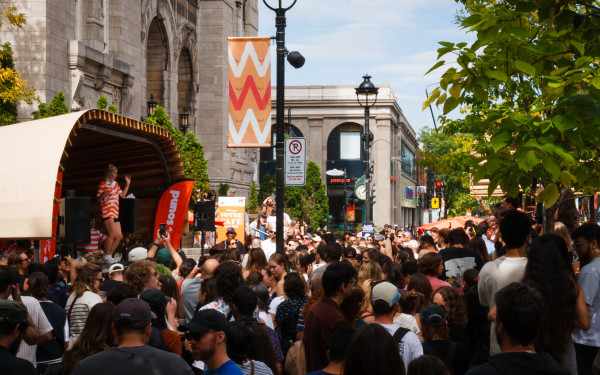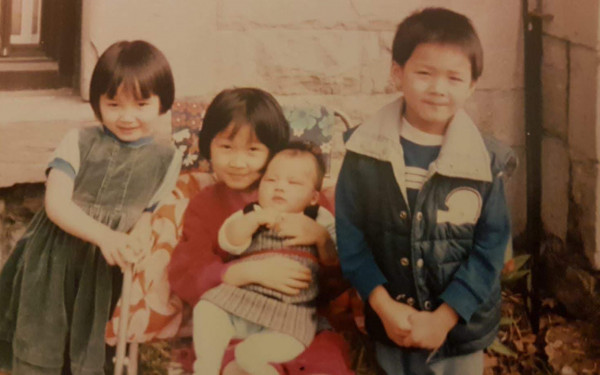Drinking to Forget
Inside Diana Bar and the Hidden World of First Nations Alcohol Abuse
All throughout the year, pockets of homeless people are found scattered along the streets of Montreal, particularly in the Atwater area.
Although they are shunned by darting eyes, many find comfort in each other’s company. Without a place to call home, many take refuge in local bars, the most infamous of which is Bar Diana.
Bittersweet Diana
Walking into the bar, you are overwhelmed by the sound of slot machines colliding with blaring music coming from the jukebox by the bare dance floor. Despite the loud ambience, the bar is mostly empty—aside from people standing by the beer taps or crowding around the VLTs. Passing by a few people in front of the large, dirt-stained window, one man lights a cigarette and eventually wanders towards the crowd outside.
In front of the dimly lit establishment on Ste. Catherine Street West, the huddle of smokers talk loudly amongst themselves. When asked what brought them together, one man responds that this is where many Cree and Inuit people gather. The man, who wishes to remain anonymous, is from The Great Whale River and is visiting friends from his native reserve as his mother is undergoing surgery at a local hospital.
While he plans on returning to his reserve, the same cannot be said for many other aboriginal people who make the trek to Montreal only to find themselves in places like Bar Diana.
Maria Peluso, a human rights activist and Concordia University professor, said that it is desperation that draws them to the city.
“They’ve either been rejected by their own communities or they are having trouble coping with their marginality,” said Peluso, adding that many have a difficult time dealing with the busy nature of the city, as they are used to the quiet environment typical of reserves.
“In effect, they are becoming part of a growing number of aboriginals living in city centres.”
Peluso has worked with many aboriginal women as the former President of Chez Doris, a centre for itinerant women. She is familiar with the popularity of the bar, which she jokingly calls “Sweet Diana.”
“Bar Diana is a local bar, not an elegant bar, it’s quite a rowdy type of bar because so many of the other bars have shut down,” said Peluso. “It’s a seedy kind of a bar for a lot of people who are homeless—a lot of native people, drug users and prostitutes.”
An employee of the neighbouring store, Romance, is familiar with the rowdy crowd that Bar Diana attracts. Emanuelle has seen many fights outside, the worst of which was when someone threw a
chair through the bar’s front window. While she has only stepped inside the bar once, she seems to have a clear picture of its bleak reality.
“It’s always full starting in the morning until when I’m gone at midnight,” she recounts. “There are always people and they’re always very drunk. I don’t want to be rude but it sure is not classy at all. There are a lot of drug addicts that take crack [cocaine] in our store and things like that.”
*The Lingering Shadow
of Abuse*
The problem of addiction amongst aboriginals is a daunting reality, both in rural areas and on the reserves. The fatality rate due to alcohol abuse is almost twice the rate of the general population and drug-related deaths are nearly three times that of non-aboriginals, according to a study done by the National Native Addictions Partnership Foundation in 2000.
Peluso points the finger at “us” for alcohol abuse problems in places like Bar Diana, as she blames Canada’s colonial ancestors for introducing alcohol to their culture. She said that alcohol is poison to their immune systems, referring to research completed by Health Canada. Alcohol is also responsible for the higher incidence of violent crimes among our First Nations.
In saying “us,” Peluso mainly refers to the Canadian government and its oppressive history, like the creation of the residential school system. The system, which was aimed towards assimilating aboriginals into Canadian society, flourished in the 20th century and stripped aboriginals of their language, culture and human rights.
Not only did our colonial ancestors introduce liquor to native populations, but they also drove them to abuse it after being physically, mentally and sexually abused by the teachers and priests who ran the residential schools.
Adrienne Campbell, who volunteers for La Nation Autochtone du Québec, a Montreal Aboriginal homeless shelter, said that abuse is a common thread woven through the stories of many aboriginal homeless people. In her experience, the problems range from physical violence in residential schools to emotional trauma inflicted by their parents, which drive many to drink.
This sentiment is reflected in a 2003 report written by the Aboriginal Healing Foundation, based on the experience of 127 Aboriginal residential school survivors. The survey reveals that prior to entering a residential school, only 17.9 per cent had abused alcohol, in comparison to the 90.9 per cent who abused alcohol after leaving the schools. Among the people surveyed, only two of the 127 survivors did not experience some degree of sexual, physical or psychological abuse.
Freddy Taylor is one of the many faces behind these statistics.
Originally from Curve Lake in Peterborough, Ont., Freddy was forced into a residential school at the age of six.
Throughout the 10 years that he was there, he said he was beaten for being native and for speaking his only known language, Ojibwa. His identity was stripped from him as he was referred to as “number 39,” the only name that stuck with him as he not only eventually forgot his parents’ names, but where he came from.
When Freddy was released from the school, any recollection of his parents had been shattered when he saw how his absence had changed them.
“When I [was sent to the residential school], I can’t remember my parents ever drinking alcohol, but when I came back, they were alcoholics,” he remembers. “During those 10 years, I never got to see them or anything. So that’s probably the reason they drank, because their kids got taken away.”
He returned to the reserve at the age of 16.
“I was let off in a car and I see this little old lady coming out of my parents’ house. It was my mom, and she had something in her hand, which I found out later was wine. So I took a drink of that and it [triggered] a lot of pain and culture shock.”
Longing to erase the memories of the residential school, Freddy said he drank to numb the pain, but found drinking only made the pain worse.
“I drank to try and fit in but then I got addicted to alcohol and taken to prison for fighting and stealing,” said Freddy. He explained that he quickly turned to crime because drinking was the only way he knew how to deal with his pain and anger, and subsequently the drinking made him act out violently.
Freddy said he fit into the prison system, as it was like being in the residential school system, yet not as bad.
After spending many years in and out of jail, he began expressing his anger through art, which he creates at the Whetung Gallery on Curve Lake. He also said that he overcame his addiction through his newfound belief in the Great Creator, who he claims helps him from day to day.
After being sober for 25 years, Freddy, now 63, is confident that his own creations have helped him overcome his past drinking habits.
“I don’t need alcohol now that I’ve got my artwork to heal me. It was due to the residential school that I drank. I’ll never drink again. Well, I can’t say that, but I hope I never drink tomorrow.”
*Federal Funding: *
Cutting Corners
While Freddy was able to heal through his art, many other aboriginals find it hard to access therapy. Campbell said that it is hard for aboriginals to reach out to a healing program for problems such as alcohol abuse. It is especially difficult for them to seek out programs if they are not run in an aboriginal manner, where their unique traditional and communal values are integrated into the holistic healing process. Campbell suggests more outreach and public awareness in Montreal is needed to facilitate changes in the system.
“It doesn’t help to just throw money into Health Canada and expect them to go and get the help,” said Campbell. Even when they do get help, Campbell points out that it’s often not adequate.
“Another huge issue is that the residential school system has been going on for over a 100 years, and they expect healing to happen in less than 10 years. That just doesn’t make sense.”
The health of aboriginal peoples is threatened in light of the Harper government’s funding cuts to The Healing Centre Foundation, which funds 134 centres across Canada. The funding of the Foundation, which was granted $350 million in 1998, was not renewed in the federal budget last March, abandoning many traditionally-run aboriginal healing centres.
In fact, since these cuts were made, many of them have been forced to shut down, a large number of which were located in rural areas.
Peluso is outraged by the federal government’s action and believes them to be morally reprehensible. In terms of a solution, she suggests “a concerted effort. You need to look at the problem, which is well known and develop a program, a policy—that’s what government is there for. Where are they? It’s not rocket science. If you have an urban drug or alcohol problem among First Nations people, then you have a program that responds to that problem. You don’t ignore it and then complain that we have bars like Bar Diana.”
In fact, she said that she’s glad Bar Diana exists, if only because they don’t have anywhere else to go.
Taylor is not too bothered by the Healing Fund cuts—he believes the money is mismanaged anyhow. In his view, the money should be given directly to residential school survivors.
“They’ve got the names of the survivors. So what if they drink or do drugs? It’s their right to spend the money.”
While Freddy thinks that places such as Bar Diana prevent the integration of aboriginals into society, he believes it is also hard for them to do so if they don’t have equal rights. In the case of Freddy and other aboriginals, their lives have been marked by the denial of due rights.
“So let’s raise a glass to ‘Sweet Diana,’ the type of joint that caters to the cultural alienation of our First Nations people stuck in the cycle of poverty, homelessness, and violence. It’s for them that Diana Bar exists, a gathering place of broken souls,” said Peluso.
From the outside, Bar Diana is a cold and gloomy place. Inside, there’s an unusual warmth—the warmth of a place where the marginalized can be among equals.
This article originally appeared in Volume 31, Issue 07, published September 28, 2010.

__900_600_90.jpg)
__900_600_90.jpg)
_600_832_s.png)

_600_375_90_s_c1.jpg)


